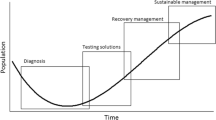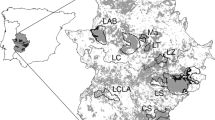Abstract
Variations in habitat quality impact on breeding success, leading to strong selection pressure for the best sites to be occupied first during a population increase and last during a decline. Coupled with dispersal and metapopulation processes, the result is that snapshot surveys of wildlife distributions may fail to reveal core areas that conservation seeks to protect. At a local scale, territory occupancy is a good indicator of quality but data are not readily available to assess occupancy for rarer species, in remote areas, and over large spatial extents. We introduce temporal suitability analysis as a way to generate an analogue of occupancy from a single survey and illustrate it using data on the little bustard in Spain. We first used Generalised Additive Modelling (GAM) to build a predictive distribution model using Geographic Information System (GIS) coverages and satellite imagery, and then applied the model retrospectively to a time series of satellite images to produce one distribution map for each year. These annual maps differed in the extent of Spain predicted as suitable for little bustards. By overlaying the maps, we identified areas predicted as suitable in one to n years. We show that this temporal suitability map correlates with a conventional habitat suitability map based on a single year but contains extra information on hierarchical use of habitats and the lag between suitability and use. The technique may be applied at a variety of spatial scales to reveal changes in expected occupancy as land use or external factors determining land cover types vary over time.
Similar content being viewed by others
Abbreviations
- AUC:
-
Area under the curve (used for ROC plots)
- AVHRR:
-
Advanced Very High Resolution Radiometer
- DTM:
-
Digital terrain model
- GAM:
-
Generalised Additive Modelling
- GLM:
-
Generalised Linear Modelling
- GIS:
-
Geographic Information System
- HSI:
-
Habitat Suitability Index
- NDVI:
-
Normalised Difference Vegetation Index
- ROC:
-
Receiver Operating Characteristics (curve)
References
Beck JB, Shultz EK (1986) The use of relative operating characteristic (ROC) curves in test performance evaluation. Arch Pathol Lab Med 110:13–20
Brotons L, Manosa S, Estrada J (2004) Modelling the effects of irrigation schemes on the distribution of steppe birds in Mediterranean farmland. Biodivers Conserv 13:1039–1058
Brown JL (1969) The buffer effect and productivity in tit populations. Am Nat 103:347–354
Brown JH, Kodric-Brown A (1977) Turnover rates in insular biogeography: effect of immigration on extinction. Ecology 58:445–449
Buckland ST, Elston DA (1993) Empirical models for the spatial distribution of wildlife. J Appl Ecol 30:478–495
Eastman JR (2000) Idrisi for windows. User’s guide version 32. Clark Labs, Clark University, Worcester, USA
Fielding AH, Bell JF (1997) A review of methods for the assessment of prediction errors in conservation presence/absence models. Environ Conserv 24:38–49
Fielding AH, Haworth PF (1995) Testing the generality of bird–habitat models. Conserv Biol 9:1466–1481
Fretwell SD, Lucas JHJ (1970) On territorial behaviour and other factors influencing habitat distribution in birds. Acta Biotheor 19:16–36
Groves RH, Austin MP, Kaye PE (2003) Competition between Australian native and introduced grasses along a nutrient gradient. Austral Ecol 28:491–498
Guisan A, Hofer U (2003) Predicting reptile distributions at mesoscale: relation to climate and topography. J Biogeogr 30:1233–1243
Guisan A, Zimmermann NE (2000) Predictive habitat distribution models in ecology. Ecol Model 135:147–186
Guisan A, Edwards TC, Hastie T (2002) Generalized linear and generalized additive models in studies of species distributions: setting the scene. Ecol Model 157:89–100
Hanski I (1999) Metapopulation ecology. Oxford University Press, Oxford
Heegaard E, Birks HH, Gibson CE, Smith SJ, Wolfe-Murphy S (2001) Species-environmental relationships of aquatic macrophytes in Northern Ireland. Aquat Bot 70:175–223
IUCN (2003) Red list of threatened species. http://www.redlist.org. Downloaded on 08 October 2004
Jaberg C, Guisan A (2001) Modelling the distribution of bats in relation to landscape structure in a temperate mountain environment. J Appl Ecol 38:1169–1181
Kokko H (1999) Competition for early arrival in migratory birds. J Anim Ecol 68:940–950
Krebs JR (1971) Territory and breeding density in the Great Tit, Parus major L. Ecology 52:1–22
Leathwick JR, Austin MP (2001) Competitive interactions between tree species in New Zealand’s old-growth indigenous forests. Ecology 82:2560–2573
Lehmann A, Overton JM, Leathwick JR (2002) GRASP: generalized regression analysis and spatial prediction. Ecol Model 157:189–207
Maggini R, Guisan A, Cherix D (2002) A stratified approach for modeling the distribution of a threatened ant species in the Swiss National Park. Biodivers Conserv 11:2117–2141
Manel S, Williams HC, Ormerod SJ (2001) Evaluating presence–absence models in ecology: the need to account for prevalence. J Appl Ecol 38:921–931
Martí R, del Moral JC (eds) (2003) Atlas de las Aves Reproductoras de España, Dirección General de Conservación de la Naturaleza. Sociedad Española de Ornitología, Madrid
Newton I (ed) (1989) Lifetime reproduction in birds. Academic Press, London
Nicholls AO (1989) How to make biological surveys go further with generalised linear models. Biol Conserv 50:51–75
Osborne PE, Alonso JC, Bryant RG (2001) Modelling landscape-scale habitat use using GIS and remote sensing: a case study with great bustards. J Appl Ecol 38:458–471
Osborne PE, Tigar BJ (1992) Interpreting bird atlas data using logistic models: an example from Lesotho, Southern Africa. J Appl Ecol 29:55–62
Pearce J, Ferrier S (2000a) An evaluation of alternative algorithms for fitting species distribution models using logistic regression. Ecol Model 128:127–147
Pearce J, Ferrier S (2000b) Evaluating the predictive performance of habitat models developed using logistic regression. Ecol Model 133:225–245
Pulliam HR (1988) Sources, sinks, and population regulation. Am Nat 132:652–661
Rao CRN, Chen J (1995) Intersatellite calibration linkages for the visible and near-infrared channels of the advanced very high-resolution radiometer on the NOAA-7, NOAA-9, and NOAA-11 spacecraft. Int J Remote Sensing 16:1931–1942
Seoane J, Bustamante J, Díaz-Delgado R (2004) Competing roles for landscape, vegetation, topography and climate in predictive models of bird distribution. Ecol Model 171:209–222
Sergio F, Newton I (2003) Occupancy as a measure of territory quality. J Anim Ecol 72:857–865
Silva JP, Pinto M, Palmeirim JM (2004) Managing landscapes for the little bustard Tetrax tetrax: lessons from the study of winter habitat selection. Biol Conserv 117:521–528
Suárez-Seoane S, Osborne PE, Alonso JC (2002) Large-scale habitat selection by agricultural steppe birds in Spain: identifying species-habitat responses using generalised additive models. J Appl Ecol 39:755–771
Teixeira J, Arntzen JW (2002) Potential impact of climate warming on the distribution of the golden-striped salamander, Chioglossa lusitanica, on the Iberian Peninsula. Biodivers Conserv 11:2167–2176
Van Horne B (1983) Density as a misleading indicator of habitat quality. J Wildlife Manage 47:893–901
Venables WN, Ripley BD (1999) Modern applied statistics with S-Plus. Springer, New York
Whittingham MJ, Wilson JD, Donald PF (2003) Do habitat association models have any generality? Predicting skylark Alauda arvensis abundance in different regions of southern England. Ecography 26:521–531
Wint WGR, Robinson TP, Bourn DM, Durr PA, Hay SI, Radolph SE, Rogers DJ (2002) Mapping bovine tuberculosis in Great Britain using environmental data. Trends Microbiol 10:441–444
Wolff A, Paul J-P, Martin J-L, Bretagnolle V (2001) The benefits of extensive agriculture to birds: the case of the little bustard. J Appl Ecol 38:963–975
Zimmermann NE, Kienast F (1999) Predictive mapping of alpine grasslands in Switzerland: species versus community approach. J Veget Sci 10:469–482
Acknowledgements
We thank the many people who provided us with distribution data for the little bustard in Spain. The AVHRR data were provided by NERC’s Satellite Receiving Station at Dundee and were processed by the RSDAS, Plymouth. We especially wish to thank Neil Lonie and Luke Tudor for their help, and Tim Smyth for carrying out the corrections for filter degradation. Thanks are also due to Pilar García for help in building the DTM in INDUROT (Universidad de Oviedo). Susana Suárez-Seoane was funded through a Marie Curie postdoctoral fellowship under EC programme ENV4-CT98-5130.
Author information
Authors and Affiliations
Corresponding author
Rights and permissions
About this article
Cite this article
Osborne, P.E., Suárez-Seoane, S. Identifying Core Areas in a Species’ Range Using Temporal Suitability Analysis: an Example Using Little Bustards Tetrax Tetrax L. in Spain. Biodivers Conserv 16, 3505–3518 (2007). https://doi.org/10.1007/s10531-006-9058-1
Received:
Accepted:
Published:
Issue Date:
DOI: https://doi.org/10.1007/s10531-006-9058-1




